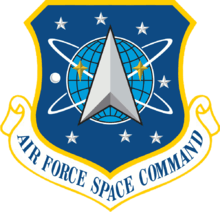7th Space Warning Squadron
| 7th Space Warning Squadron | |
|---|---|
|
7th Space Warning Squadron emblem | |
| Active | 1992-Present |
| Country | United States |
| Branch | United States Air Force |
| Type | Space Operations |
| Role | Missile Warning |
| Part of | 21st Space Wing/AFSPC |
| Garrison/HQ | Beale Air Force Base |
| Decorations |
|
The 7th Space Warning Squadron (7th SWS) guards the U.S. West Coast against sea-launched ballistic missiles from the eastern outskirts of Beale Air Force Base approximately 8 miles (13 km) east of Marysville, California. The 7th SWS is a geographically separated unit of the 21st Space Wing, Peterson Air Force Base, Colorado Springs, Colorado.[1]
Mission
SLBM detection
The 7th SWS is primarily responsible for detecting submarine-launched ballistic missiles (SLBM) fired in the Pacific Ocean. The unit then determines how many missiles in flight, probable destination, and reports to the North American Aerospace Defense Command's missile warning center, Cheyenne Mountain AFS; United States Strategic Command, Offutt Air Force Base; and National Command Authority. This unit helps form a two-layered, worldwide network of missile warning systems that also detects ICBMs launched toward North America.[1]
Speed is a key factor in day-to-day squadron activities. Within 60 seconds after detecting a launch, the crew on duty has to determine if the detection is valid, under investigation, or anomalous due to computer, mechanical or personnel error. After that, the crew determines the number of launched vehicles and provides impact predictions on North America. Once the information is determined, the unit passes updates to the appropriate authorities.[1]
ICBM detection
The 7th SWS's corollary mission of Missile Defense supports the Ground-Based Midcourse Defense (GMD) element of the Ballistic Missile Defense System. This program's objective is the defense of the United States against a threat of a limited strategic ballistic missile attack. The unit's Upgraded Early Warning Radar (UEWR) detects, acquires, and tracks inbound missiles to provide the necessary data to classify and engage the target. This target data allows the GMD Fire Control and Communications element to generate a weapons task plan, allowing for the engagement, interception, and negation of threat of a ballistic missile reentry vehicle in the exoatmospheric region of space.[1]
Satellite catalog
In addition, the squadron helps track earth-orbiting satellites, and reports the information to the Joint Space Operations Center (JSpOC) at Vandenberg Air Force Base, northwest of Lompoc, California. This information is then combined with information from other sensors to form a satellite catalog. The JSpOC uses the catalog to keep track of more than 16,000 objects in orbit. The catalog is also used to generate the United Nations Registry Report, so national and international agencies can make sure new satellites will safely launch and orbit.[1]
Equipment
The PAVE PAWS radar uses nearly 3,600 small active antenna elements coordinated by two computers. One computer is on-line at all times, while the second automatically takes control if the first fails. The computers control the distribution of energy to the antennas to form precise patterns, allowing the radar to detect objects moving at a very high speed since no mechanical parts limit the radar sweep. The radar can change its point of focus in milliseconds, while conventional radars may take up to a minute to mechanically swing from one area to another. The main building is shaped like a pyramid with a triangular base 105 feet on each side. The two radiating faces are tilted back 20 degrees. Pave PAWS radar beams reach outward for nearly 3,000 nautical miles in a 240-degree sweep. At its extreme range, it can detect an object the size of a small car. Smaller objects can be detected at closer range.[1]
History
The Air Force finished construction of the PAVE PAWS site at Beale in October 1979. The unit was originally part of Aerospace Defense Command 26th Aerospace Division. In December 1979, it became part of Strategic Air Command. It attained initial operational capability in August 1980.[1]
The unit transferred to Air Force Space Command in May 1983, eventually becoming the 7th Missile Warning Squadron. When the Air Force reorganized in 1992, the 21st Space Wing activated at Peterson AFB. The 7th MWS moved to the 21st SW and was renamed the 7th SWS. In 2007, 7th SWS completed the upgrade to Upgraded Early Warning Radar.[1]
Previous designations
- 7th Space Warning Squadron (1991–Present)
- 7th Missile Warning Squadron (1979-1991)
Assignments
Major Command
Air Force Space Command
Numbered Air Force
Wing/Group
Commanders
- Lt Col Dale R. Madison (20 Aug 1996–1998)[2]
- Lt Col Dale Shirasago (1998-2000)
- Lt Col Dane Hollenga (2000-2002)
- Lt Col Scott M. Schroff (2010-2012)
- Lt Col Mark J. Sorapuru (2012–2014)
- Lt Col Miguel A. Cruz (2014-2016)
- Lt Col Jason L. Terry (2016-Present)
Decorations
References
- 1 2 3 4 5 6 7 8 "7th Space Warning Squadron". Factsheet. United States Air Force. 16 August 2012. Retrieved 10 April 2013.
- ↑ AFHRA FOIA Req 09-0061: 21st Space Wing Roster of Key Personnel (as of 31 December 1996)
- ↑ AFSPC Special Order GA-62, 6 December 1999
- ↑ AFSPC Special Order GA-58, 6 December 1999
